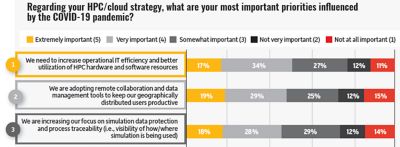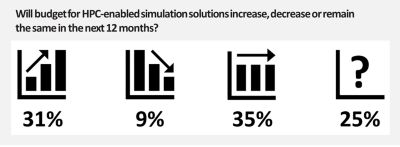-
United States -
United Kingdom -
India -
France -
Deutschland -
Italia -
日本 -
대한민국 -
中国 -
台灣
-
Ansys si impegna a fare in modo che gli studenti di oggi abbiano successo, fornendogli il software gratuito di simulazione ingegneristica.
-
Ansys si impegna a fare in modo che gli studenti di oggi abbiano successo, fornendogli il software gratuito di simulazione ingegneristica.
-
Ansys si impegna a fare in modo che gli studenti di oggi abbiano successo, fornendogli il software gratuito di simulazione ingegneristica.
-
Contattaci -
Opportunità di lavoro -
Studenti e Accademici -
Per Stati Uniti e Canada
+1 844.462.6797
ANSYS BLOG
May 10, 2021
Survey Shows Emerging Cloud Computing Capabilities and the COVID-19 Effect
In our previous post, we discussed the findings of our 2020 research survey on the use of high-performance computing (HPC) resources for engineering simulation. While that article focused on the engineering challenges that have made it necessary for engineering organizations to adopt on-premises, cloud-based and ISV-managed HPC resources, we now turn our attention to the increased use of cloud computing for simulation.
While cloud adoption has been growing in all sectors over the past decade, many organizations that had previously been hesitant to shift applications to the cloud or to use cloud-based compute resources were suddenly forced to make a decision in 2020. As engineers began working from home during the COVID-19 pandemic and design firms struggled to find ways to collaborate with clients and vendors, cloud growth accelerated. This had a measurable effect on engineering IT priorities.
Accelerating Simulation via the Cloud
In the previous blog, we outlined how engineers face computing resource constraints when it comes to increasing the use of simulation and accelerating the design cycle. Engineers have been tasked with completing more complex simulations more frequently, but face long solve times and often have to reduce model sizes and/or complexity, which degrades the quality of the results.
The cloud has become an important deployment model for accelerating those simulation times. More than a quarter of survey respondents indicated that the use of a public cloud solution or ISV-managed solution could reduce turnaround time limitations on simulation (compared to 12% in our 2014 survey).
There has been healthy adoption of cloud resources in simulation, but there is still room to grow. According to the survey, 18% of respondents are using the cloud for engineering simulation, and another 18% plan to use the cloud over the next 12 months.
Speed is not the only factor that influences the cloud deployment decision. When it comes to cloud use in general, engineering organizations are looking for the ability to improve collaboration, burst out to the cloud when additional compute capacity is needed, and to integrate and synchronize simulation results with other enterprise applications.
High-performance computing/cloud computing simulation survey respondents ranked collaboration as the most important cloud-enabled simulation capability.
The COVID-19 Effect on HPC/Cloud Computing Strategies
The need for remote work and collaboration capabilities caught many engineering organizations flat-footed in 2020, and there were several key lessons learned over the past year. Those are reflected in how the pandemic has impacted these organizations' HPC priorities.
High-performance computing/cloud computing simulation survey respondents are focused on increasing efficiencies in the wake of the COVID-19 pandemic.
The most important priorities influenced by the COVID-19 pandemic are to increase operational IT efficiency and better utilize HPC hardware and software resources (51% of respondents), followed by the adoption of remote collaboration and data management tools to keep geographically distributed users productive (46%).
And these organizations have not slowed their spending on HPC. Despite the economic upheaval caused by the global COVID-19 pandemic, only 9% indicated that their HPC-enabled simulation budgets would be reduced, 25% were unsure and 31% expected budgets to increase.
Almost a third of the respondents to our survey on high-performance computing usage for engineering simulation plan to increase their HPC-enabled budgets over the next 12 months.
Simulation Via the Cloud Meets Engineering Challenges
Simulation plays an increasingly critical role in the design cycle, but engineers face difficult challenges when it comes to computing resources, IT support and time constraints. Cloud-based HPC resources can help unlock the potential of engineering simulation while also reducing the need for additional investment in new hardware and IT resources. The pandemic further highlights the value of being able to tap into critical applications and HPC resources while working and collaborating remotely.
Read Part 1 of this blog series: “Simulation User Survey Results: Evolving Workflows Affect HPC Usage.”
For more detailed insights, please download the full Study on High-Performance Computing Usage for Engineering Simulation.














